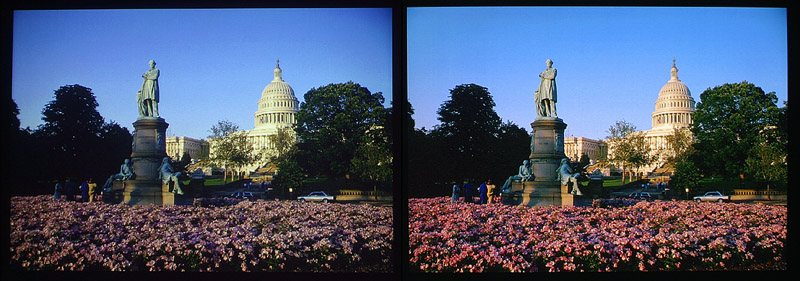
The achievable image quality essentially depends on contrast and color rendering. Only high contrast allows nuanced image display rich in tonal value.
Even more important than the brightness is the contrast ratio, i.e. the difference between the brightest and the darkest tonal value to be displayed. In projecting a brilliant slide we can achieve a contrast ratio of 1000 : 1, while video projectors have a contrast ratio between 300 : 1 and more than 2000 : 1 depending on the model. Devices with DLP chip, in particular, show very high rates, which can also be reproduced in practical tests. For good and photorealistic display of pictures the video projector should have a contrast ratio of more than 800 : 1. With too low a contrast ratio, the projector, for example, may not be able to display black. It then looks as though there was a gray veil over the picture and dark areas frequently lack contrast.
Color rendering essentially depends on the image chip and the lamp used. Most image chips, in particular LCD panels, are not able to display all tonal values equally well. And, what makes things even worse, the most frequently used UHP lamps show a discontinuous spectrum, i.e. some colors are stronger than others.
Some color hues are critical for data projectors, such as red and yellow, for example, and can cause a particularly unpleasant effect with regard to skin colors. Data projector manufacturers are trying to optimize color fidelity through intensive color signal processing. Systems with three separate image chips, e.g. one for each of the colors red – green – blue, have a distinctly better basis for color rendering than one-chip systems. For DLP systems, however, the color wheel, which is responsible for color creation, has been distinctly improved. Modern one-chip DLP projectors have a very fast color wheel with six segments (RGBRGB) which provides for very balanced color rendering. Be warned of DLP video projectors with 4-segment color wheel containing a white segment (RGBW). These devices feature very moderate color rendering with a distinct weakness in red and yellow as well as mediocre color gradation. However, there are also a few video projectors which allow deactivation of the white segment to improve color rendering. Other manufacturers, such as Panasonic, use pulsed lamps to achieve high-quality colors.
Projectors with a special emphasis on color fidelity and high contrast very often have a relatively low luminous flux. To achieve optimum color rendering, Xenon lamps are used for high-end applications, which have a similar spectrum in the visible range than daylight.

Left: normal system with UHP lamp, right: color-corrected JVC system
See also
Signal processing and connectors
Recommended reference video projectors